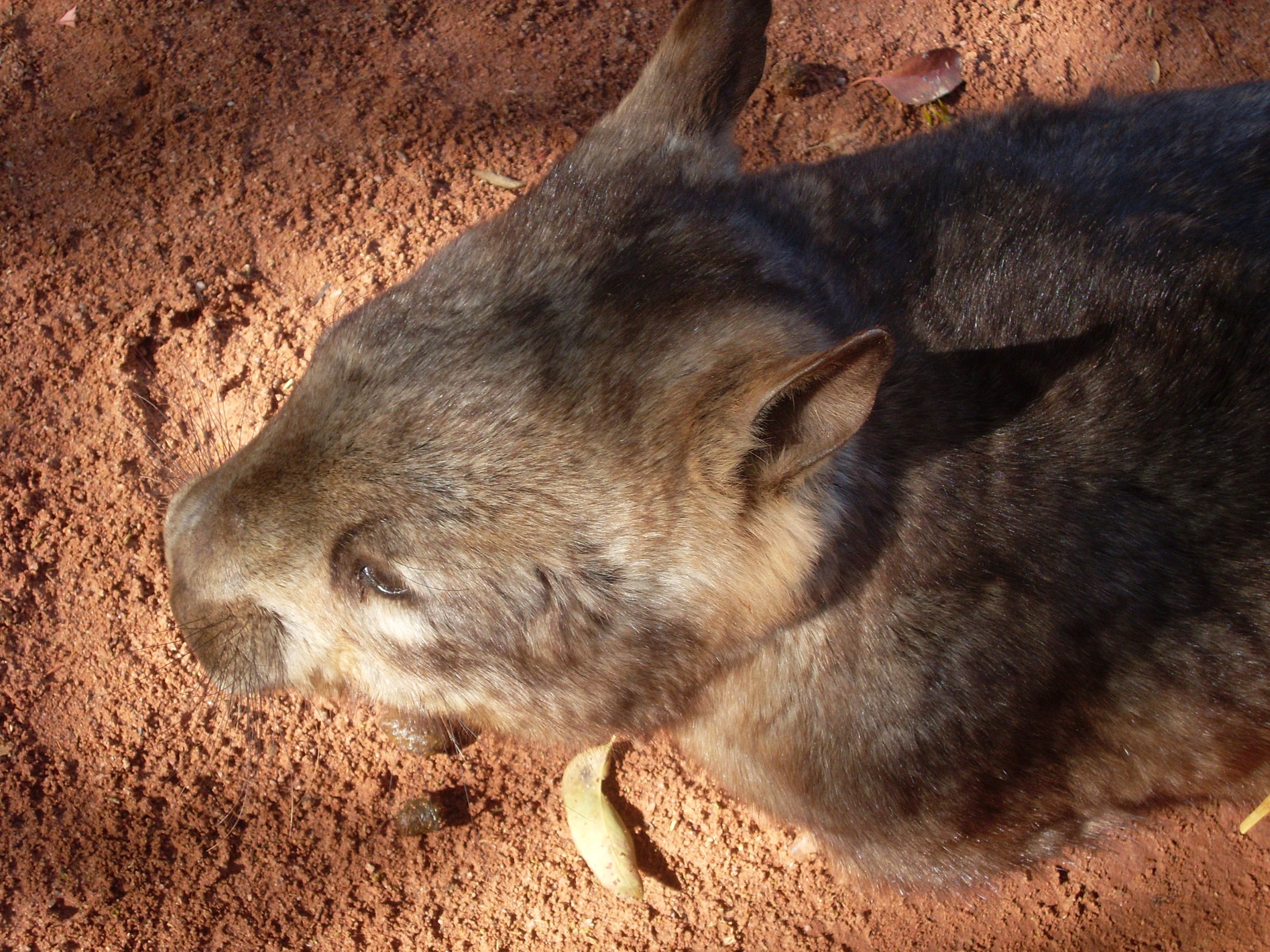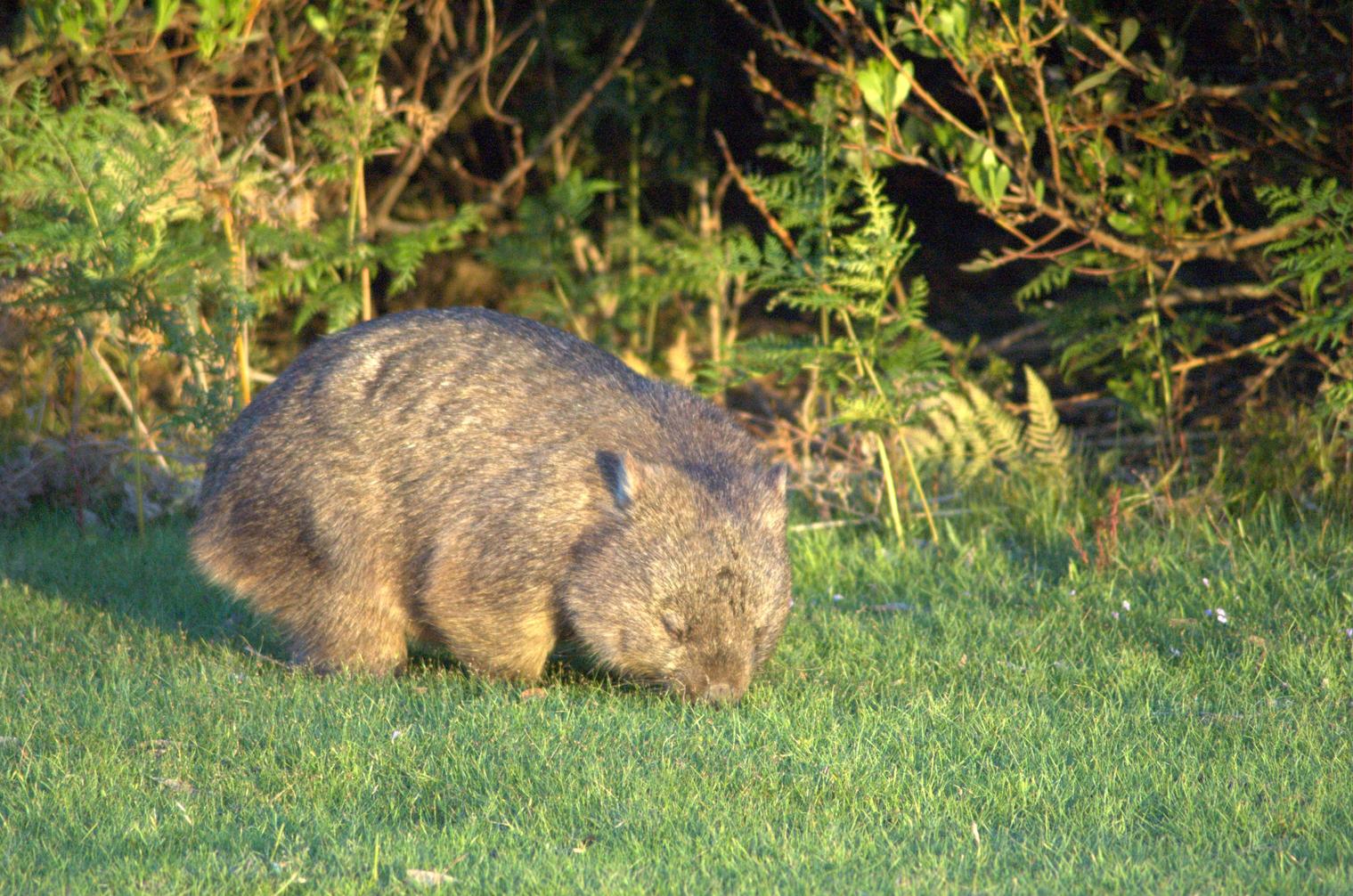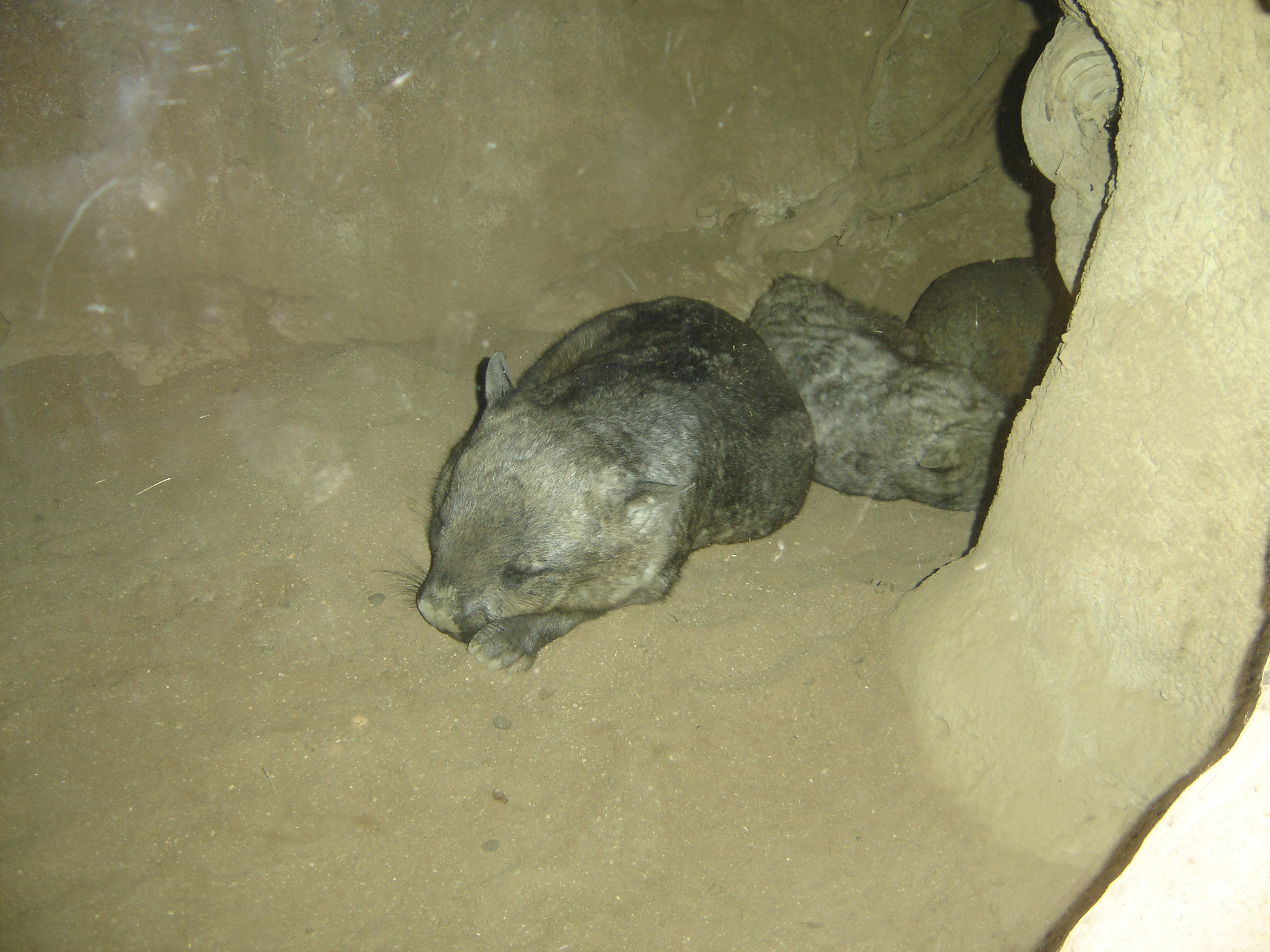|
Lasiorhinus Latifrons
The southern hairy-nosed wombat (''Lasiorhinus latifrons'') is one of three extant species of wombats. It is found in scattered areas of semiarid scrub and mallee from the eastern Nullarbor Plain to the New South Wales border area. It is the smallest of all three wombat species. The young often do not survive dry seasons. It is the state animal of South Australia. Among the oldest southern hairy-nosed wombats ever documented were a male and a female from Brookfield Zoo just outside Chicago. Their names were Carver, who lived to be 34, and his mother, Vicky, who lived to be 24. In South Australia in 2010, a domesticated wombat named Wally was also reported as having reached the age of 34. Hamlet, a wombat at the Toronto Zoo, similarly died at age 34. Taxonomy English naturalist Richard Owen described the species in 1845. There are three synonyms: * ''Phascolomys lasiorhinus'' Gould, 1863 * ''Lasiorhinus mcoyi'' Gray, 1863 * ''Phascolomys latifrons'' Owen, 1845 Description The ... [...More Info...] [...Related Items...] OR: [Wikipedia] [Google] [Baidu] |
Wombat
Wombats are short-legged, muscular quadrupedal marsupials that are native to Australia. They are about in length with small, stubby tails and weigh between . All three of the extant species are members of the family Vombatidae. They are adaptable and habitat tolerant, and are found in forested, mountainous, and heathland areas of southern and eastern Australia, including Tasmania, as well as an isolated patch of about in Epping Forest National Park in central Queensland. Etymology The name "wombat" comes from the now-nearly extinct Dharug language spoken by the aboriginal Dharug people, who originally inhabited the Sydney area. It was first recorded in January 1798, when John Price and James Wilson, a white man who had adopted aboriginal ways, visited the area of what is now Bargo, New South Wales. Price wrote: "We saw several sorts of dung of different animals, one of which Wilson called a "Whom-batt", which is an animal about 20 inches high, with short legs and a thick bod ... [...More Info...] [...Related Items...] OR: [Wikipedia] [Google] [Baidu] |
Southern Hairy-Nosed Wombat
The southern hairy-nosed wombat (''Lasiorhinus latifrons'') is one of three extant species of wombats. It is found in scattered areas of semiarid scrub and mallee from the eastern Nullarbor Plain to the New South Wales border area. It is the smallest of all three wombat species. The young often do not survive dry seasons. It is the state animal of South Australia. Among the oldest southern hairy-nosed wombats ever documented were a male and a female from Brookfield Zoo just outside Chicago. Their names were Carver, who lived to be 34, and his mother, Vicky, who lived to be 24. In South Australia in 2010, a domesticated wombat named Wally was also reported as having reached the age of 34. Hamlet, a wombat at the Toronto Zoo, similarly died at age 34. Taxonomy English naturalist Richard Owen described the species in 1845. There are three synonyms: * ''Phascolomys lasiorhinus'' Gould, 1863 * ''Lasiorhinus mcoyi'' Gray, 1863 * ''Phascolomys latifrons'' Owen, 1845 Description Th ... [...More Info...] [...Related Items...] OR: [Wikipedia] [Google] [Baidu] |
Richard Owen
Sir Richard Owen (20 July 1804 – 18 December 1892) was an English biologist, comparative anatomist and paleontologist. Owen is generally considered to have been an outstanding naturalist with a remarkable gift for interpreting fossils. Owen produced a vast array of scientific work, but is probably best remembered today for coining the word '' Dinosauria'' (meaning "Terrible Reptile" or "Fearfully Great Reptile"). An outspoken critic of Charles Darwin's theory of evolution by natural selection, Owen agreed with Darwin that evolution occurred, but thought it was more complex than outlined in Darwin's ''On the Origin of Species''. Owen's approach to evolution can be considered to have anticipated the issues that have gained greater attention with the recent emergence of evolutionary developmental biology. Owen was the first president of the Microscopical Society of London in 1839 and edited many issues of its journal – then known as ''The Microscopic Journal''. Owen also c ... [...More Info...] [...Related Items...] OR: [Wikipedia] [Google] [Baidu] |
Standard Metabolic Rate
Basal metabolic rate (BMR) is the rate of energy expenditure per unit time by endothermic animals at rest. It is reported in energy units per unit time ranging from watt (joule/second) to ml O2/min or joule per hour per kg body mass J/(h·kg). Proper measurement requires a strict set of criteria to be met. These criteria include being in a physically and psychologically undisturbed state and being in a thermally neutral environment while in the post-absorptive state (i.e., not actively digesting food). In bradymetabolic animals, such as fish and reptiles, the equivalent term standard metabolic rate (SMR) applies. It follows the same criteria as BMR, but requires the documentation of the temperature at which the metabolic rate was measured. This makes BMR a variant of standard metabolic rate measurement that excludes the temperature data, a practice that has led to problems in defining "standard" rates of metabolism for many mammals. Metabolism comprises the processes that the bod ... [...More Info...] [...Related Items...] OR: [Wikipedia] [Google] [Baidu] |
Captivity
Captivity, or being held captive, is a state wherein humans or other animals are confined to a particular space and prevented from leaving or moving freely. An example in humans is imprisonment. Prisoners of war are usually held in captivity by a government hostile to their own. Animals are held in captivity in zoos, and often as pets and as livestock. Definition and scope Captivity is the state of being captive, of being imprisoned or confined. The word derives from the late Middle English ''captivitas'', and the Latin ''captivus'' and ''capere'', meaning to seize or take, which is also the root of the English word, "capture". In humans, captivity may include arrest and detention as a function of law enforcement and a civilian correctional system, detention of combatants in a time of war, as well as human trafficking, slave taking, and other forms of involuntary confinement, forced relocation, and servitude. In non-human animals, captivity may include confinement for the purpos ... [...More Info...] [...Related Items...] OR: [Wikipedia] [Google] [Baidu] |
Hindgut Fermentation
Hindgut fermentation is a digestive process seen in monogastric herbivores, animals with a simple, single-chambered stomach. Cellulose is digested with the aid of symbiotic bacteria.Animal Structure & Function . Sci.waikato.ac.nz. Retrieved on 2011-11-27. The occurs in the digestive organs that follow the : the |
Essential Nutrient
A nutrient is a substance used by an organism to survive, grow, and reproduce. The requirement for dietary nutrient intake applies to animals, plants, fungi, and protists. Nutrients can be incorporated into cells for metabolic purposes or excreted by cells to create non-cellular structures, such as hair, scales, feathers, or exoskeletons. Some nutrients can be metabolically converted to smaller molecules in the process of releasing energy, such as for carbohydrates, lipids, proteins, and fermentation products (ethanol or vinegar), leading to end-products of water and carbon dioxide. All organisms require water. Essential nutrients for animals are the energy sources, some of the amino acids that are combined to create proteins, a subset of fatty acids, vitamins and certain minerals. Plants require more diverse minerals absorbed through roots, plus carbon dioxide and oxygen absorbed through leaves. Fungi live on dead or living organic matter and meet nutrient needs from their hos ... [...More Info...] [...Related Items...] OR: [Wikipedia] [Google] [Baidu] |
Gut Microbiota
Gut microbiota, gut microbiome, or gut flora, are the microorganisms, including bacteria, archaea, fungi, and viruses that live in the digestive tracts of animals. The gastrointestinal metagenome is the aggregate of all the genomes of the gut microbiota. The gut is the main location of the human microbiome. The gut microbiota has broad impacts, including effects on colonization, resistance to pathogens, maintaining the intestinal epithelium, metabolizing dietary and pharmaceutical compounds, controlling immune function, and even behavior through the gut–brain axis. The microbial composition of the gut microbiota varies across regions of the digestive tract. The colon contains the highest microbial density recorded in any habitat on Earth, representing between 300 and 1000 different species. Bacteria are the largest and to date, best studied component and 99% of gut bacteria come from about 30 or 40 species. Up to 60% of the dry mass of feces is bacteria. Over 99% of the b ... [...More Info...] [...Related Items...] OR: [Wikipedia] [Google] [Baidu] |
Urea
Urea, also known as carbamide, is an organic compound with chemical formula . This amide has two amino groups (–) joined by a carbonyl functional group (–C(=O)–). It is thus the simplest amide of carbamic acid. Urea serves an important role in the metabolism of nitrogen-containing compounds by animals and is the main nitrogen-containing substance in the urine of mammals. It is a colorless, odorless solid, highly soluble in water, and practically non-toxic ( is 15 g/kg for rats). Dissolved in water, it is neither acidic nor alkaline. The body uses it in many processes, most notably nitrogen excretion. The liver forms it by combining two ammonia molecules () with a carbon dioxide () molecule in the urea cycle. Urea is widely used in fertilizers as a source of nitrogen (N) and is an important raw material for the chemical industry. In 1828 Friedrich Wöhler discovered that urea can be produced from inorganic starting materials, which was an important conceptual milestone ... [...More Info...] [...Related Items...] OR: [Wikipedia] [Google] [Baidu] |
Anterior
Standard anatomical terms of location are used to unambiguously describe the anatomy of animals, including humans. The terms, typically derived from Latin or Greek roots, describe something in its standard anatomical position. This position provides a definition of what is at the front ("anterior"), behind ("posterior") and so on. As part of defining and describing terms, the body is described through the use of anatomical planes and anatomical axes. The meaning of terms that are used can change depending on whether an organism is bipedal or quadrupedal. Additionally, for some animals such as invertebrates, some terms may not have any meaning at all; for example, an animal that is radially symmetrical will have no anterior surface, but can still have a description that a part is close to the middle ("proximal") or further from the middle ("distal"). International organisations have determined vocabularies that are often used as standard vocabularies for subdisciplines of anatomy ... [...More Info...] [...Related Items...] OR: [Wikipedia] [Google] [Baidu] |
Colon (anatomy)
The large intestine, also known as the large bowel, is the last part of the gastrointestinal tract and of the digestive system in tetrapods. Water is absorbed here and the remaining waste material is stored in the rectum as feces before being removed by defecation. The colon is the longest portion of the large intestine, and the terms are often used interchangeably but most sources define the large intestine as the combination of the cecum, colon, rectum, and anal canal. Some other sources exclude the anal canal. In humans, the large intestine begins in the right iliac region of the pelvis, just at or below the waist, where it is joined to the end of the small intestine at the cecum, via the ileocecal valve. It then continues as the colon ascending the abdomen, across the width of the abdominal cavity as the transverse colon, and then descending to the rectum and its endpoint at the anal canal. Overall, in humans, the large intestine is about long, which is about one-fifth o ... [...More Info...] [...Related Items...] OR: [Wikipedia] [Google] [Baidu] |
Caecum
The cecum or caecum is a pouch within the peritoneum that is considered to be the beginning of the large intestine. It is typically located on the right side of the body (the same side of the body as the appendix, to which it is joined). The word cecum (, plural ceca ) stems from the Latin '' caecus'' meaning blind. It receives chyme from the ileum, and connects to the ascending colon of the large intestine. It is separated from the ileum by the ileocecal valve (ICV) or Bauhin's valve. It is also separated from the colon by the cecocolic junction. While the cecum is usually intraperitoneal, the ascending colon is retroperitoneal. In herbivores, the cecum stores food material where bacteria are able to break down the cellulose. In humans, the cecum is involved in absorption of salts and electrolytes and lubricates the solid waste that passes into the large intestine. Structure Development The cecum and appendix are formed by the enlargement of the postarterial segment of ... [...More Info...] [...Related Items...] OR: [Wikipedia] [Google] [Baidu] |







